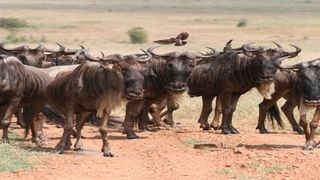
A herd of wildebeest in the Maasai Mara Game Reserve on July 7, 2021. They are the first batch to cross from the Serengeti, kicking off the peak tourist season in the Mara.
| George Sayagie | Nation Media GroupNews
Premium
Changing weather patterns disrupt wildebeest migration in Mara-Serengeti region
What you need to know:
- Rehabilitation of Mau complex expected to reverse changes.
- The animals are increasingly spending less time in Maasai Mara.
Erratic weather patterns brought about by global warming are impacting wildebeest migration patterns in the Mara-Serengeti ecosystem, scientists have warned.
The movements have traditionally been influenced by rainfall and new vegetation growth, which have changed over the last few years.
Scientists based in the ecosystem, including Par Lemein, say the change in the length and timing of the rainy season is slowly reducing the time wild animals spend in the Maasai Mara wildlife reserve – they migrate to the Mara late and return to Serengeti earlier than anticipated.
Mr Lemein, who has studied the patterns for the last 10 years, says that in the near future, this is likely to directly affect the thousands of tourists who visit the Mara from across the world during the annual wildebeest migration.
He said this year’s migration has been delayed and conservationists and ecologists attribute this to a change in weather patterns.
Normally, the spectacle begins in mid June, continuing to September. By this time the herds, would turned the grassland into a black mass, but only a small number have arrived.
“The frequency of severe droughts increased and floods intensified in the Maasai Mara before 2018, but for the last two years or so there has been moderate rain due to the restoration of the Maasai Mau forest,” said Mr Lemein.
Wildebeests' long trek
More than 1.5 million wildebeests migrate every year from Tanzania to Kenya in mid-June before heading back in September to calf. The migration involves mainly wildebeests, elands and zebras.
In 2019, the wildebeests started their long trek on June 1 and stayed up to November due to lush grass and rains in the Mara. The last such occurrence happened in 2013 when they came in late May, said Mara-Serengeti ecosystem chair Nick Ole Murero
“Climate changes such as heavy rains in Tanzania as well as depletion of resources are among the reasons we have an early or delayed wildebeest migration,’’ he said.
Daniel Karino, a tour guide and wildlife expert in the Mara, says the patterns this year are alarming after only about 300 crossed over a week ago. But the migration stopped, with the herds spotted grazing along Sand river on the Serengeti side.
On Wednesday this week the crossing resumed, indicating a breaking sequence.
The yearly cycle begins in southern Serengeti, where half a million calves are born between January and March. When the rains end in May, the land dries up quickly and the grazers must move on, heading for their dry-season refuge in the Mara.
The migration takes place across 150,000 square miles of woodland, hills and open plains across the two reserves.
Wildebeest populations
The Mara-Serengeti ecosystem and the adjoining game-controlled areas have only one permanent river, the Mara. Until 2018, it was evident that the water level in the key river had dropped drastically.
“This climate change issue and the occupation of the Mau Forest before the 2018/19 eviction negatively affected wild animals,” said Mietamei Ololdapash, a Maasai land activist in the Mara.
Though there is enough water now in the river after the settlers were evicted, Mr Ololdapash’s concerns are inspired by the irregular flow of the Mara and its main tributary, the Talek, which has become more and more extreme, with conservationists warning it might cause a collapse in the wildebeest populations.
This was linked to the destruction of the Mau forest complex, Nyakweri forest and the Loita forest.
It is believed that the climate change effects could be reversed with the rehabilitation and conservation of the Mau forest complex.
that has led to increased water levels in the Mara River.
Delegates from Kenya and Tanzania during the Mara Day celebrations hosted by Bomet County last year said there was a need to sustain efforts to conserve the Mara Basin, a regional resource.
Mau forest complex
The government started the rehabilitation of the Mau forest complex by evicting more than 60,000 settlers and planting trees.
“There is a need for conservation upstream with the planting of environmentally friendly trees along rivers and springs so as to curb pressure on underground water,” said Bomet Governor Hillary Barchok during the celebrations at the Mara Serena.
Local tour operators and hoteliers have so far raised the red flag over the current human population growth rate coupled with excessive exploitation of natural resources win the core areas of the Mara River basin.
However, all is not lost.
The Narok County government in 2018 imposed a permanent ban on charcoal making and logging following a widespread outcry over the loss of forests.
Governor Samuel ole Tunai’s announcement followed Deputy President William Ruto’s suspension of logging in all forests the same year as water levels in major rivers countrywide continued to drop at alarming levels.
Mr Tunai said all logging activities in the Mau forest, Nyakweri forest in Transmara, Enoosupukia forest in Narok East and Loita forest in Narok South have been banned and declared illegal.
“We are also rolling out a massive afforestation programme to plant trees in the Mau and along the riparian areas of the Mara River,” he said.





